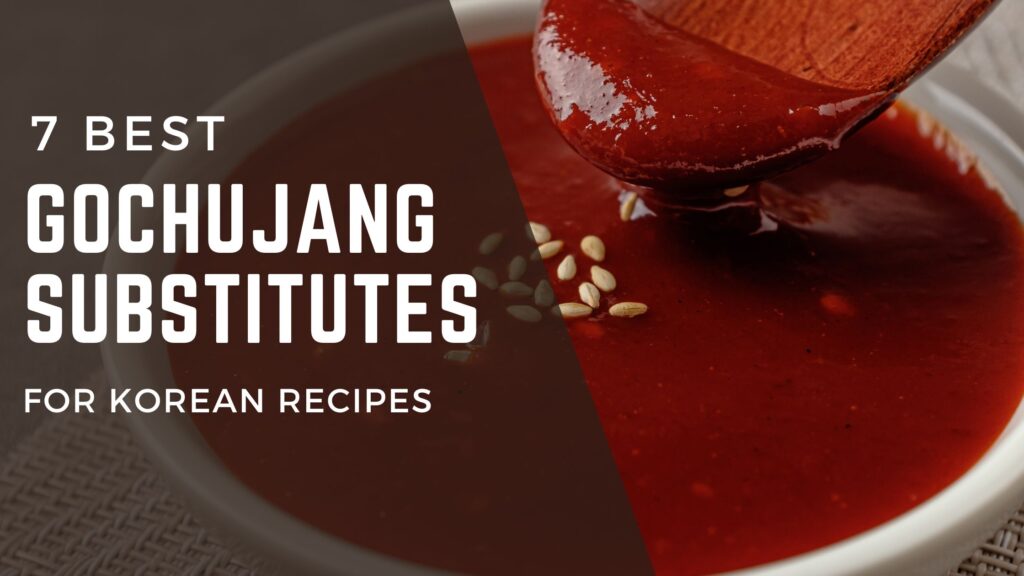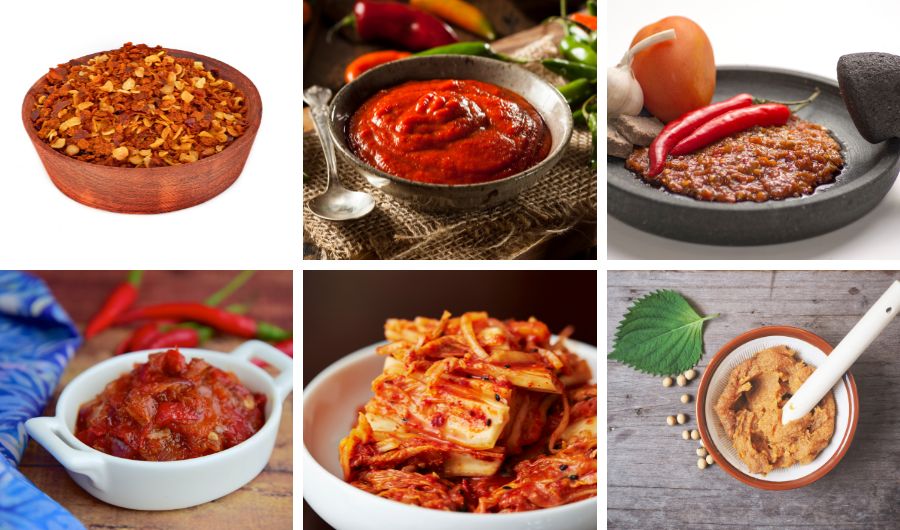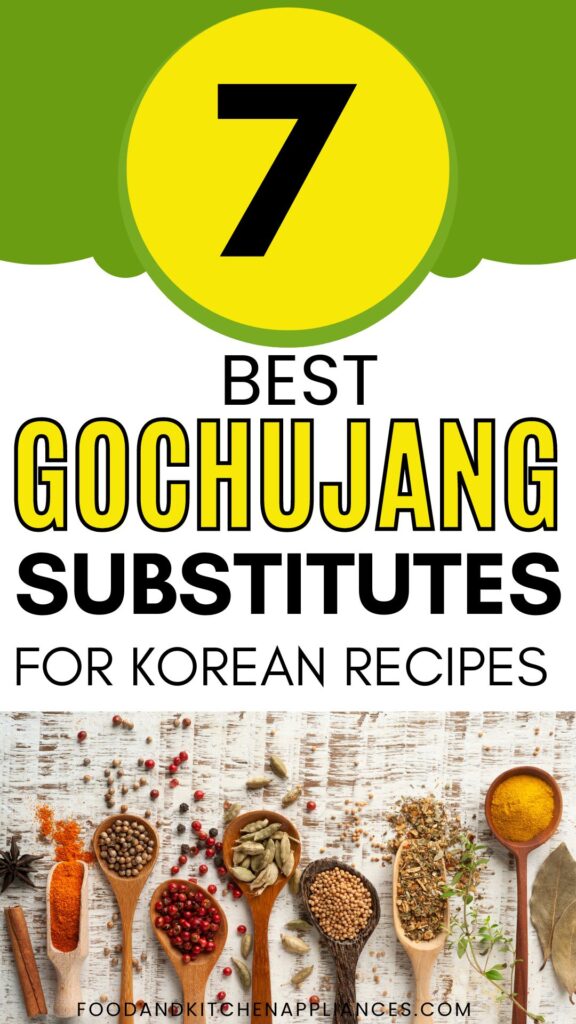Gochujang is a popular Korean condiment from fermented soybeans, chili peppers, and glutinous rice. It is a staple ingredient in many Korean dishes, from bibimbap to tteokbokki. However, gochujang may not be readily available in some areas or may not be suitable for those with specific dietary restrictions. In such cases, finding the best gochujang substitutes is essential.
One substitute for gochujang is a combination of chili paste, soy sauce, and sugar. This mixture can be adjusted to taste, with more or less sugar, depending on the desired level of sweetness. Another option is to use a mixture of red pepper flakes, rice vinegar, and miso paste. This combination provides a similar level of heat and umami flavor as gochujang.
A mixture of chili paste, rice vinegar, and honey can be used for those looking for a gluten-free alternative to gochujang. While these substitutes may not be the same as gochujang, they can be used to create delicious Korean-inspired dishes suitable for various dietary needs.

What is Gochujang?
Gochujang is a savory, spicy, and slightly sweet fermented chili paste that is a staple in Korean cuisine. It is made from chili powder, glutinous rice, fermented soybeans, and salt.
Gochujang has a deep, complex flavor that is spicy and sweet. It is used as a marinade, a dipping sauce, a condiment, and a cooking ingredient in many Korean dishes, such as bibimbap, tteokbokki, and bulgogi.
The main ingredients of Gochujang are:
- Glutinous rice powder
- Korean red chili powder
- powdered fermented soybeans (meju)
- Barley malt powder
- And salt
Why Substitute for Gochujang?
Gochujang is a staple ingredient in Korean cuisine, known for its unique sweet, spicy, and savory flavor. However, it can be challenging to find in some areas or may not be an option for those with dietary restrictions. In these cases, finding a suitable substitute for gochujang is essential.
Additionally, some people may simply not enjoy the taste of gochujang. While it is a beloved ingredient in Korean cuisine, it may not be everyone’s liking. In these cases, finding an alternative that provides a similar flavor profile can allow individuals still to enjoy Korean-inspired dishes without the overpowering taste of gochujang.
Best Substitutes for Gochujang
When you’re cooking Korean recipes, Gochujang is an essential ingredient. It’s a fermented chili paste that adds a spicy and savory flavor to dishes. However, if you can’t find Gochujang in your local stores or are looking for a substitute, red pepper flakes, Sriracha sauce, Harissa Paste, Red chili paste, Miso paste, Sambel Oelek, or Chili paste can do owners.

1. Red Pepper Flakes
Red pepper flakes are a common substitute for Gochujang. They are made from dried and crushed red chili peppers and add a spicy kick to dishes.
However, they lack the sweetness and umami flavor of Gochujang. If using red pepper flakes as a substitute, mix them with soy sauce, sugar, and vinegar to get a similar flavor profile to Gochujang.
2. Sriracha Sauce
Sriracha sauce is a famous hot sauce made from chili peppers, vinegar, garlic, and sugar. It has a spicy and sweet flavor profile similar to Gochujang but lacks the fermented taste.
Mix Sriracha sauce as a substitute with soy sauce, sugar, and vinegar to get a closer flavor to Gochujang.
3. Ssamjang –
An excellent alternative to Gochujang, Ssamjang is a spicy and savory blend of Korean chili and fermented soybean paste.
Using it as a dip or marinade rather than an all-purpose condiment works better. The robust flavors of this blend bring out the best in grilled meats and vegetables, making it an excellent choice for barbecue lovers and vegetarians alike. Ssamjang is full of umami goodness and provides a unique flavor to any dish that calls for Gochujang.
4. Chili Paste
Chili paste is a generic term for any paste made from chili peppers. It can be used as a substitute for Gochujang in some recipes, but it lacks Gochujang’s fermented flavor and sweetness.
If using chili paste as a substitute, mix it with soy sauce, sugar, and vinegar to get a similar flavor profile to Gochujang.
5. Sambal Oelek
Sambal Oelek is an Indonesian chili paste made from ground chili peppers, vinegar, and salt. It has a spicy and tangy flavor and can be used as a substitute for Gochujang in some recipes.
However, it lacks the sweetness and umami flavor of Gochujang. If using Sambal Oelek as a substitute, mix it with soy sauce, sugar, and vinegar to get a similar flavor profile to Gochujang.
6. Kimchi Paste
Kimchi paste is a Korean condiment from fermented cabbage, chili peppers, garlic, and ginger. It has a similar flavor profile to Gochujang, but it lacks sweetness.
If using Kimchi paste as a substitute, mix it with sugar and vinegar to get a closer flavor to Gochujang.
7. Miso Paste
Miso paste is an excellent alternative for those looking for a substitute for the beloved gochujang. Made from fermented soybeans and salt, this condiment has a creamy texture and salty umami flavor that can turn a simple dish into something special.
Miso paste’s slightly sweet yet savory taste allows it to be used in various recipes such as dumplings, soups, marinades, broths, and sauces. Miso paste delivers the desired flavors for your favorite dishes.
How to Use Gochujang Substitutes
Measurement Conversion
When using a substitute for gochujang, it’s essential to know how to convert the measurements. If the recipe calls for 1 tablespoon of gochujang, you can use 1 tablespoon of any of the substitutes mentioned earlier.
However, if the recipe calls for 1/4 cup of gochujang, you can use 1/4 cup of the substitute, but it may alter the flavor and texture of the dish. It’s recommended to start with a smaller amount of the substitute and adjust according to taste.
Flavor Profile
While gochujang substitutes can provide a similar flavor profile, it’s important to note that they may not be identical to gochujang. Some substitutes may be spicier or sweeter than gochujang, so it’s important to taste test and adjust accordingly.
For example, using sriracha as a substitute may be spicier than gochujang, so it’s recommended to use less and add more if needed.
It’s also important to consider the texture of the substitute. Some substitutes may be thinner or thicker than gochujang, affecting the dish’s texture. For example, if using miso paste as a substitute, it may be thicker than gochujang, so it’s recommended to dilute it with water or other liquids to achieve a similar consistency.

Non-spicy substitute for gochujang
Shiro Miso – Shiro miso is a white, sweet miso paste made with only rice and salt. It has slight spiciness but still provides plenty of umami flavor to dishes. In comparison to other types of miso, Shiro miso is milder and sweeter, making it perfect for those who don’t like spicy food. It can make sauces, dressings, soups, and marinades with subtle sweetness without any heat.
Best Gochujang substitutes for tteokbokki
Gochujang may be the traditional condiment used in tteokbokki recipes, but some great substitutes will still give your dish an irresistible flavor.
One option is to combine red chili paste and tomato paste to get the same sweet-spicy flavor as gochujang.
Another option is to use gochujang-style chili pastes like sambal oelek or sriracha for a similar taste. Finally, if you’re looking for something with less spice, Shiro miso paste can also be a delicious substitute that won’t overwhelm your tastebuds. No matter which condiment you choose,
Is gochujang the same as chili paste?
No, gochujang is not the same as chili paste. Gochujang is a Korean condiment made from red chili peppers, glutinous rice powder, fermented soybeans, and salt.
Chili paste is a generic term for any sauce made with chili peppers, while gochujang has an unmistakable flavor profile due to its unique ingredients and fermentation process.
So while chili paste is a broad term covering many different types of sauces, gochujang has a distinct flavor and texture that makes it stand out.
Conclusion
While gochujang is a unique ingredient that is hard to substitute, several alternatives can be used. The substitute choice will depend on the prepared dish and the desired flavor profile.
Sriracha sauce is a good option for those who want a similar flavor and heat level. It has a similar sweet and spicy taste and can be found in most grocery stores.
If spiciness is not a concern, miso paste can be used as a substitute. It has a similar umami flavor and can be found in most Asian grocery stores.
For those who want a milder flavor, soy sauce mixed with chili flakes or powder can be used. This will give the dish a salty and slightly spicy taste.
